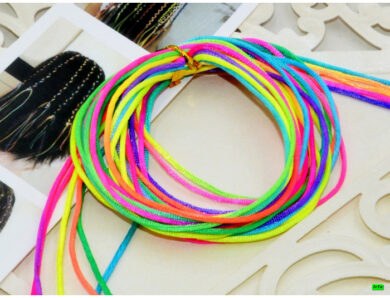PVA wire (PUGNP, PUGSP): technical parameters and interpretation of abbreviations
Electricity, numerous electrical appliances and mechanisms for various purposes in all spheres of human life and… wires, wires, wires! Wires and network cables are an industry today. They differ in brands, appointment, current conductivity and technical characteristics.
Alphanumeric marking of PVA
Today the range of these products is presented on the market in a wide range. At the buyer's choice - products with different design of cores and insulation coatings. All cables and wires are marked, which can determine the technical characteristics of these products and select the desired product for the desired purpose.
PVA wire, construction
PVA is a connecting wire in vinyl insulation . It consists of two or more copper, twisted and isolated multi-wire cores, dressed in a protective shell of polyvinyl chloride. Depending on the brand, PVA cable has a different cross-sectional shape and a different set and structure of conductive cores. The amount of copper (or aluminum) lived from 2 to 5, intersection in the range from 0,5 to 25 mm2, shell - rubber (rubberized) or traditional PVC. The color of the PVA insulation shell is white, black or gray. Insulation colors lived by the standard: brown, black and red-phase, blue - zero, yellow-green color - grounding.
Where PVA wire is used
Copper multicore PVA cable is used to transmit low signal voltage of low power devices. In everyday life, it is used to connect to the network of almost all electrical appliances and machines, providing voltage to 220/380 V, in the frequency range up to 50 Hz. It can be used for internal wiring of living quarters and for the work of specialized equipment in the garden.
PVA is widely used at some stages in industrial production. Thanks to that, that the PVA cable is well deformable and can withstand the maximum possible number of bends, it is very widely used for the manufacture of extension cords (transfer) of different lengths, as well as the installation of outdoor lighting and illuminated advertising.
PVA wire with aluminum core is designed for voltage transmission in urban electric lighting networks. Such wires are electrical equipment and wiring in modern residential buildings and factories, where high power is required: large metallurgical plants, enterprises of different specialization, power plant…
Features and benefits of PVA cable
The main characteristics of PVA:
-
The temperature of the environment of use from -40 to +40 degrees
- The maximum heating temperature of the conductor +70 degrees in the working phase
- Resource of trouble-free operation of a wire - 5000 hours, service life - 6 years
- PVA is resistant to corrosion, mold, fungus
- Not toxic, non-flammable
- The length of the construction cable is 50 meters
- Operating electrical resistance in the range 1 km is approximately equal to 270 Ohm
- At nominal stress, the resistance to variable deformation in bending is approximately from 30000 to 60000 cycles
PVA with copper cores has a number of advantages:
- Strength
- Plasticity
- High coefficient of resistance
- High conductivity
- High percentage of thermal expansion
- Anti-corrosion
- Easy repair
- Compatibility with regulating rheostats and insulators
Features of PVA with aluminum cores:
- Aluminum PVA cores are not heated, and this has a positive effect on the speed of electric current and its power
- Unlike copper, aluminum filaments are oxidized by oxides, which prolongs their service life and makes it possible to use them in chemical production, production of rolled metal
- PVA cable with aluminum core is more economical, as it weighs an order of magnitude less than copper. As a result, it has found its application in power transmission masts, as it allows to stretch lines without additional supports
- Aluminum wire is cheaper than copper, it is flexible and quite durable. The resource of wire use is minimal 5 years
Deciphering of PVA marking
All conductors, offered on the market of electrical equipment, have a marking certificate and must comply with the system of the State Standard of Russia. Distinguish these products by the abbreviation PVA, which represents the technical characteristics of the wire, purpose and scope of its use.
Power cable from PVC, rubber insulation:
-
KG - flexible
- A - 1st letter: aluminum core, in its absence - a copper vein
- B - polyvinyl chloride insulation
- B is the second letter: polyvinyl chloride shell
- P - no cover, "naked"
- ng - does not burn
- LS - Low Smoke - release of gas and smoke
- BB - a cover from steel tapes, armored
- Shv - external PVC hose
Cable (BPI) with insulation of impregnated paper:
- A - 1st letter: aluminum core, in its absence - a copper vein
- AB - aluminum armor
- SAT - the first or second letter: lead armor
- l - tape of mylar
- 2l - double ribbon of mylar
- P - no cover, "naked"
Telephone cable:
-
T - telephone cable
- P - polyethylene insulation
- n - belt insulation: polyamide, polyethylene, polyvinyl chloride or polyethylene terephthalate tapes
- E - screen
- P - polyethylene shell
- C is a hydrophobic filler
- Shp - outer cover - polyethylene hose
- C - station cable
Suspended wires:
- And bare aluminum wire
- Speaker - steel-aluminum bare wire
- SIP is a self-supporting wire, isolated
Control cable:
- To - the first or second letter: control cable (except CG)
- E - screen
A special way to decrypt some types of cable:
- KSPV - in a vinyl cover for system transfer
- KPSVV - cables with vinyl insulation and vinyl sheath for fire alarm
- KPSVEV - with vinyl insulation, with screen and vinyl shell for fire alarm
- PNSV - heating wire with steel housing in a vinyl shell
- PV-1, PV-3 - with vinyl insulation of the 1st, 3-th class of flexibility lived
- PVA is a connecting wire in a vinyl shell
- ShVVP - a cord flat with vinyl isolation and a vinyl cover
- PUNP - universal flat
- PUGNP - universal flat flexible wire
Power cable:
- N - VDE compliant
- Y - polyvinyl chloride
- H - halogen-free polyvinyl chloride
- M - cable for installation
- C - copper screen
- RG - armor
Vita pair cable:
- U - unfoiled: unfoiled, non-codings
- F - broken: foiling, shielded
- S — screened: shielded with copper wires
- S-F - general wicker screen made of foil
- S-S is the screen of each pair: with foil and wicker screen
- TP - twisted pair - twisted pair
Telephone cable, fire alarm cable:
- J - installation installation cable
- Y - polyvinyl chloride
- (St) - foil screen
Fireproof halogen-free cable:
- N - VDE compliant
- HX - rubber sewn
- C - copper screen
- FE 180 - cable properties are stored for a certain time (180 minutes) in an open flame and under voltage
Mounting wires:
- H - harmonized wire (HAR approval)
- N - meets the national standard
- 05 - High-voltage 300/500 V, nominal
- 07 - voltage 450/750 V, nominal
- V - polyvinyl chloride insulation
- K - flexible core for stationary installation
Cable (Italy) has a specific marking according to CEI UNEL 35011:
- F - corda flessibile - flexible vein
- R - polivinilclorudo - PVC - polyvinyl chloride insulation
- O - anime riunite per cavo rotundo - round cable, non-flat
- R - polyvinyl chloride - PVC - polyvinyl chloride shell
Cross-linked polyethylene cables with insulation:
- N - VDE compliant
- Y - polyvinyl chloride
- 2Y - polyethylene
- 2X - cross-linked polyethylene
- S - copper screen
- (F) - longitudinal sealing
- (FL) - longitudinal sealing, transverse
- E - cable with 3 alive
- R - armored with round steel threads
- J - is a yellow-green vein
- O - no yellow-green vein
Control cable:
- Y - polyvinyl chloride
- SL - control cable
- Li is a conductor for VDE, multiple
PUGNP cable: appointment, marking
PUGNP wire is designed for laying lighting networks indoors, as well as for the supply of electricity to household appliances and small industrial machinery and units, where the required rated power is 250 In alternating current. According to the system of the State Standard of the Russian Federation, PUGNP wire is issued according to TU 16K13-020-93 and has a number of the main characteristics and the marking.
Decryption of abbreviations:
- the letter "A" is initially missing, means wire with copper cores;
- the first letter "P" -wire;
- letters "UN" -universal purpose;
- the letter "P" is flexible;
- the last letter "P" is flat.
PUGNP is a wire with twisted copper cores with PVC sheath and PVC plastic insulation, flat. Since this type of wire is intended mainly for domestic use, Technical specifications are set with the limitation of the necessary requirements for the parameters of construction and electrical conductivity.
This wire has 2 or 3 lived with a cross section from 0, 35 to 6,0 mm2 and each of the cores must consist of at least 7 conductive threads. The color of the PVC shell is mostly white or natural, radial thickness-0,5 mm The color of the insulation of all veins must be different. Blue for zero and yellow-green for ground are required. Minimum insulation thickness-0,3 mm.
All about PUGSP
PUGSP wire is a twisted copper wire - a plait. It is available in two colors and comes in standard sizes. PUGSP is used for power grids in lighting, as well as for connecting household appliances and electrical outlets with voltage 250 In alternating current at frequency 50 Hz. The wire consists of three cores and double PVC insulation. Construction length (bay) wire is 50 meters, cross section - 2.5 mm.
Multi-wire cores (2 or 3 in the wire) round copper or aluminum, are located parallel to each other. The insulation has a standard color and thickness 0,3 mm.
PUGSP shell made of polyvinyl chloride plastic and has a radial thickness 0,5 mm.
Technical parameters of PUGSP:
- The cable is designed to operate in temperatures from -15 to +50 degrees.
- In a single location and laying does not burn
- Electrical resistance is 27,1 Ohm on the control plot length 1 km, cross section in 1 mm2 and at temperature +20 degrees
- The length of the construction wire is 5 meters




